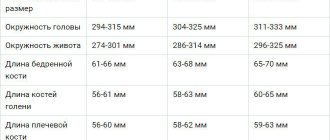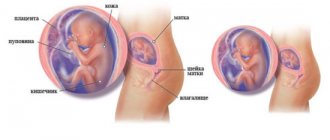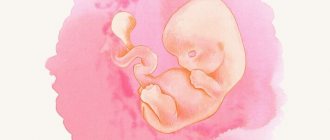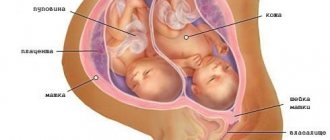Baby at 29 weeks of pregnancy
At this period, the active development of the fetus still occurs, 29 weeks of pregnancy is the period at which the full functioning of the immune, digestive, urinary and other systems in the baby’s body is noted. His kidneys excrete approximately half a liter of urine daily, and the gastrointestinal tract is ready to accept the first portions of colostrum. The respiratory system continues its development: at week 29 there is much more surfactant, which plays an important role in human breathing.
A child at 29 weeks of pregnancy feels any changes that occur around him, which is due to the good development of the nervous system. He can not only perceive temperature changes, feel the movement, mood and well-being of his mother, as well as hear sounds and notice light stimuli, but also reacts to this. And since his muscular system is gaining strength every week, the mother feels the mood of her baby very well. The fetus at 29 weeks of gestation can already smell. Before this, his nostrils were filled with mucus plugs, but now amniotic fluid can enter his nasal cavity.
The baby’s body has become noticeably rounder, as there is more fatty tissue. And this means that his body can more likely thermoregulate. The accumulation of brown adipose tissue also affects the appearance of the fetus: the skin becomes lighter, and folds appear on the arms and legs.
The weight of a child at the 29th week of pregnancy is 1200-1300 g, his height is 39-40 cm, and his heart rate is 120-160 beats/min.
Week 29
Your baby is the size of a cabbage
Breech presentation of the fetus at 29 weeks of pregnancy
As a rule, by this time the baby becomes cramped in the space of the uterus and he already takes the position in which he will remain until birth. It happens that at week 29 the doctor determines that the fetus is positioned head up. However, it is worth noting that there is enough time before birth and the baby can still roll over. The doctor may recommend performing special exercises that will stimulate the baby to roll over. There are also special methods by which the gynecologist turns the fetus by influencing it through the wall of the pregnant woman’s abdomen.
What is the purpose of ultrasound examination?
An ultrasound scan at 29 weeks of pregnancy is not a routine examination. It is prescribed for:
- assessing the functional and physical condition of the fetus if there is a deterioration in its movements;
- determining the position of the child in the womb;
- clarification of the condition of the umbilical cord, placenta and uterus;
- determination of quantitative and qualitative characteristics of amniotic fluid;
- re-examination if the second screening revealed features in the development of the fetus.
In addition, an ultrasound scan at 29 weeks can already determine the sex of the unborn child.
What pregnancy complications can ultrasound help identify?
An ultrasound at week 29 helps detect various complications of pregnancy. If the placenta is thickened, this indicates an infection or Rh conflict. The doctor identifies how its lower edge is located relative to the internal pharynx. Normally, this figure is 6 cm. Its decrease indicates low placentation.
Sometimes the lower edge of the placenta partially or completely covers the internal os. This can lead to placental abruption and heavy bleeding. Ultrasound also helps determine the maturity of the “children's place”. It should be zero. Premature aging indicates a violation of its function. In this case, the doctor refers the woman to Doppler ultrasound to assess uteroplacental blood flow.

An ultrasound at the 29th week of pregnancy determines how many vessels are contained in the umbilical cord. Normally there are 3 of them. If there is only 1 artery in this organ, then Doppler measurements are performed.
The doctor examines the amount of amniotic fluid. A decrease in its volume is observed with an infectious disease or fetoplacental insufficiency. Polyhydramnios most often occurs due to infection. Ultrasound helps evaluate the condition of the cervix. Normally, its length is 3 cm. Its shortening is associated with isthmic-cervical insufficiency.
Based on what parameters is the condition and development of the fetus assessed?
During pregnancy, the doctor evaluates the condition and development of the fetus based on:
- data obtained by comparing gestational age and the size of the uterus and fetus;
- listening to fetal heart sounds;
- motor activity of the child;
- results of ultrasound examinations performed at 18-22 weeks, 32-33 weeks and before birth.
If pregnancy proceeds with complications, then the fetus is examined to identify signs of hypoxia. The doctor evaluates the motor activity and cardiac activity of the fetus, performs amnioscopy, ultrasound of the placenta and fetus.
Changes in the body of the expectant mother
The second trimester is over, and with it the woman’s good health remains. The larger the belly becomes, the harder the baby pushes, the more tired the expectant mother becomes. It is no longer so easy for her to move with such a burden, and many pregnant women have experienced what late toxicosis is like in the third trimester. However, it's not all bad. A woman lives in anticipation of meeting her baby, and his movements and kicks are a wonderful way to communicate with him.
It is worth noting that it is not only joy that a pregnant woman experiences. Her mood can be very changeable, which is partly due to hormonal fluctuations. A woman may be accompanied by fear and anxiety, tearfulness and irritability, which can be replaced by a good mood and bursts of tenderness. Therefore, it is important for future dads to support their spouse during this period.
The mammary glands have noticeably increased in size, and the pregnant woman notices that droplets of colostrum are sometimes released from the nipples. Remember that nipple stimulation can strain the uterine muscles, so never squeeze colostrum from your breasts.
The level of hormones during pregnancy goes through the roof, which affects completely different processes in a woman’s body. This affects not only mood changes, but also the work of the sweat glands, which begin to work harder. Therefore, expectant mothers need to take extra care of themselves and regularly carry out hygiene procedures.
Belly at 29 weeks pregnant
The tummy grows so that the growing baby does not feel cramped. In this regard, at week 29, a pregnant woman may experience a whole range of sensations. The load on the back and legs has increased, the stretched ligaments of the uterus can also remind of themselves with painful sensations, and in addition to this, the skin on the abdomen is very itchy. This is due to the fact that it stretches, but it does not always keep up with the growth of the tummy, which can lead to the formation of stretch marks. It is not always possible to prevent their occurrence, but the use of special creams and gels significantly reduces the risk of their occurrence.
The 29th week of pregnancy has arrived: a photo of the expectant mother’s belly can be added to the next photo, so do not forget to capture the changes that have happened to you.
Previous Next
The uterus rises above the level of the navel by 1 cm with each subsequent week, so the height of its fundus is already determined to be 9 cm above the navel. From time to time, the uterus may contract, thus preparing for the upcoming birth. This phenomenon is called Braxton-Hicks contractions or false contractions. As a rule, they are periodic, pass quickly and are not accompanied by pain. If a pregnant woman feels that the cramping sensations are painful, intensify over time, and the interval between them begins to shorten, this indicates the onset of premature labor. In this case, you need to urgently call an ambulance.
Fetal movements at 29 weeks of pregnancy
Many pregnant women notice that, despite the pain of their babies' kicks, communicating with them through touching the belly brings a lot of positive emotions. With the help of stroking, you can even calm down an overly active child, which confirms the existence of a bond between mother and baby. At this stage, even those around you can notice the baby’s movements and even distinguish when he hiccups and when he pushes. This makes future fathers especially happy.
At week 29, your doctor may advise you to count how many times your baby moves during the day. This is usually around 10 times, with slight variations due to differences in temperament. But the absence, decrease in the number of movements, or increased activity should alert the pregnant woman. This may be a sign of deterioration in the fetus's condition, so you should immediately consult a doctor if you notice such changes in your baby's behavior.
Childbirth at 29 weeks of pregnancy
Births that occur before 38 weeks of pregnancy are considered premature. But if we compare childbirth at the 23rd week and at the 29th week of pregnancy, we can say that at this stage the baby has a much greater chance of surviving and developing well in the future. Doctors care for babies weighing from 500 g, and at week 29 the weight is already more than 1 kg, and the organ systems have been actively developing all this time, which has significantly increased their endurance. Despite this, the baby will need active support from medical personnel so that his body can cope with the effects of various environmental factors.
Necessary tests and studies
Before each visit to the gynecologist, pregnant women must undergo a general urine test so that the doctor can be convinced of the presence or absence of various pathological processes. Also, according to indications, a general blood test, blood sugar test and Rh factor test may be prescribed.
It is quite possible that it is at the 29th week that the gynecologist will prescribe an examination of the pregnant woman by specialized specialists, which should be carried out at the 30th week of pregnancy.
During the examination, the doctor evaluates the test results, takes measurements of the abdomen, determines the height of the uterine fundus and listens to the fetal heartbeat. In addition, the woman is weighed and her blood pressure is measured.
Vitamins
Continuing our conversation about nuts, let’s say that they contain a large amount of vitamins A, C, D, E, B vitamins, as well as calcium, zinc, iron, phosphorus and magnesium, which are necessary for the 29th week. In addition, nuts contain so much protein that they can even replace meat! But nutritionists do not recommend getting carried away with nuts in large quantities (allergies may occur!), so we recommend that you get useful micro- and macroelements, including from other foods, without forgetting the vitamin complexes prescribed by your doctor.
Possible problems
- Nausea at 29 weeks of pregnancy in combination with edema and high blood pressure may indicate the presence of gestosis, which is otherwise called late toxicosis. This is a condition that requires careful monitoring of the pregnant woman’s condition, as well as adjustments with the help of nutritional recommendations and medications.
- Varicose veins and hemorrhoids are diseases that develop due to the increasing load on a woman’s body. You need to try to prevent their occurrence, so that you don’t have to suffer later trying to get rid of them.
- High weight gain is the result of poor nutrition or a sign of edema. In any case, weight must be kept under control and the reasons for its excessive increase must be understood.
- A cold is a disease that a woman may encounter during pregnancy. To avoid this, you should try not to visit crowded places where the risk of infection is much higher. And if the disease has not spared you, stay home, drink more and rest. Unfortunately, many medications that we are used to treating are prohibited during pregnancy, so in any case, consult your doctor.
- A change in the nature of the discharge, which normally should be colorless, homogeneous and odorless, indicates risks to the health of the expectant mother and her baby. Therefore, you should not delay your visit to the gynecologist. And if the discharge is bloody or the changes are accompanied by increasing pain, call an ambulance.
- Increasing fatigue is normal for a woman who is already approaching her due date. The body wears out because it works for two. This is felt both in the heaviness in the legs and in the tachycardia caused by the increased load on the heart. The main thing is to get enough rest and not exhaust yourself.
- Pregnancy is also accompanied by all the symptoms associated with increased pressure from the growing uterus on nearby organs . These include frequent urination, constipation and heartburn. The uterus can also put pressure on the inferior vena cava when a woman sits with her legs crossed or lies on her back. Because of this, the pregnant woman may feel dizzy and experience tinnitus. In this case, it is advisable to immediately change your position.
Recommendations for the expectant mother
- Nutritional recommendations for the 29th week of pregnancy include careful preparation of the diet, monitoring the amount of fluid consumed (if there is swelling) and a sufficient amount of essential nutrients. A pregnant woman's diet must contain a lot of fiber and protein, as well as foods containing calcium and iron. To reduce the likelihood of swelling, you need to reduce the amount of salt. And, of course, you should exclude fried, fatty, smoked dishes and sweets from the menu. After all, nutrition not only leaves its mark on a woman’s figure, but also directly affects the baby’s health and his future food preferences.
- Rest is an important component of a pregnant woman's daily routine. Without it, her body, already under heavy stress, becomes even more tired. In a week, the woman will already go on maternity leave, but even before this time it is necessary to get enough sleep and rest during the day.
- Communication with the baby is necessary for both his mother and himself. It is important that the woman is in a calm environment. You can establish contact with the baby by stroking his tummy and touching his arms or legs when he rests them on his stomach. It's good when mom loves to sing. Lullabies, as well as fairy tales that a child hears while in the mother’s womb, have a positive effect on his development and mood.
- If you experience symptoms that worry you , be sure to consult a doctor to rule out possible problems.
What's happening to the baby
At week 29, the baby’s weight reaches 1150 grams, height – 38.5 cm. It becomes more crowded in the womb, so the woman feels all movements very clearly. He reacts to light, sounds around him and even dreams. At this stage, some babies are already in the position necessary for childbirth - head down.
How internal organs develop
- The kidneys remove urine from the body. It enters the amniotic fluid, which is renewed every 3 hours.
- The bones and ligaments of the fetus are strengthened, for which it needs up to 300 mcg of calcium daily. Take this into account when creating your menu.
- In boys, the testicles begin to descend into the scrotum area. This process will be completed after birth. Girls' genitals are fully formed.
- The baby is protected by its own immune system, but antibodies continue to come from the mother’s blood.











